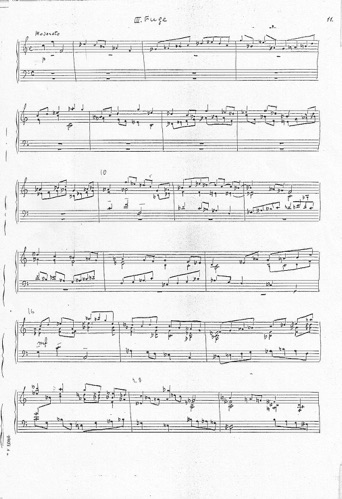

Biography:
Early Years
Leopold van der Pals was born and raised in St. Petersburg by a Dutch father and a Danish mother. At the age of 12, improvising on the piano, he started to compose music. Van der Pals started to learn the art of composing from his grandfather, Julius Johanssen, professor of kontrapunkt and director of the Conservatory in St. Petersburg. Leopold was greatly inspired by performances which was held in the home with renowned artists such as Pablo Casals, the Tchaikovsky brothers and Anton Arensky.
At the age of 19 (year 1903) van der Pals left Russia to continue his studies in Lausanne, Switzerland, with the famous Suisse composer, professor Alexander Denéréas and the cellist Tom Canivez.
After completing his studies in Lausanne 1907, van der Pals moved to Berlin. By recommendation from Sergei Rachmaninov, he now received guidance and lessons by the russian maestro and composer Reinhold Gliére. The time in Berlin was very productive for van der Pals. He was now in the center for the modern music scene and formed friendship with many of the musical personalities of that time, such as Nikisch, Weingartner, Hausegger, Eibenschütz, Havemann, Koussevitsky and Skriabin.
Van der Pals experimented with new harmonical ideas and alternative cadenzas, and was inspired by the idea of metamorphosical evolvement in the music. He now formed his personal harmonical and rhythmical language. A hybrid of different styles; romantism - impressionism - free tonality - and inspiration from russian and Nordic folklore. Van der Pals music was at this time considered to be very modern.
In Berlin
During the Berlin years, 1907-1915, van der Pals was very active and he now composed his first 30 opus. He concentrated on large format orchestral pieces and lieder, including the First Symphony in fis-Moll op. 4, the tonepoems “ Frühling und Herbst” op. 14, “Wieland der Schmied“ op. 23 and “Pan's Tod“ op. 24, the Violin Concerto op. 10 and an opera in the romantic style “Legende von der Prinzessin und dem gefesselten Jüngling” op. 17.
The first symphony was premiered in 1909 by the Berlin Philharmonic Orchestra conducted by Heinrich Schoultz. The piece was very well received in the press and this resulted in an extensive series of performances of his pieces in Europe and America. His music was performed by some of the biggest stars of this time, such as Willem Mengelberg, Sigurd Rascher, Fritz Busch, Georg Göhler, W. Safonoff, J. Eibenschütz, S. von Hausegger, H. Schulz, Josef Stransky, Gustav Havemann and Tom Canivez.
In Arlesheim
In 1915, with influence from the teolog and esotericist Rudolf Steiner, Leopold van der Pals moved to Arlesheim in Swizerland with his wife Marussja and young daughter Lea. These years (1915-1922) in Arlesheim was good for van der Pals, the career was going well, his family was well and his composing was productive and inspirational. Leopold was offered a position at the Wiener Philharmoniker as a composer and rehearsal conductor, but declined due to family conditions.
In Arlesheim he started his large series of compositions of chambermusic for various ensembles. A stringquartet, a pianotrio, a duo for cello and violin and sonatas for piano, cello and violin. In 1922 van der Pals completed the composing of his second symphony for large orchestra. The orchestration of this piece however, was interrupted when Leopolds wife, Marussja fell ill.
Years of traveling
In order to treat Marussjas condition ,the family now departed from Arlesheim. For a period of 11 years they were constantly traveling between sanatories. In this time the family stayed in approximately 80 locations in Europe, for example Disentis, Ascona, Locarno, Dalpe, Montreux, St. Quay, Glion, Champery, San Vito, Bern, Untergrainau, Lens, Kilntal, Berlin, Meran, Portofino, Freiburg and Bordighera among others. These years were very troublesome for van der Pals. The treatment was expensive, and Leopold experienced great difficulty to follow and continue his career. He had no chance to travel and hear his compositions being played as this meant leaving his family at the sanatorium. In spite of the difficult situation he continued his work and in this period he composed the stringquartets no. 2, 3 (“Metamorphosen”) and 4, a quintet for flute and strings and the second violinsonata. Van der Pals also completed four large orchestral works during this time; the third symphony called “Rhapsodie”, the “Hodler suite” for orchestra, and the two operas “Der Berg des Heiligen Michael” and “Eisenhand”.
Marussja died in 1934. Her death effected Leopold deeply. He withdrew himself to Ascona, Swizerland, and mourned the loss of his wife. Leopold wrote 80 poems to her love and memory. 45 of the poems were selected and he put them into music. The work became op. 96, ”In Memoriam” with the undertitle ”Dem Geiste meiner Frau”, 45 lieder for alto voice and piano. He then finally settled down in Dornach, Swizerland where he lived during the remaining 31 years of his life. From this point on, Leopold lived a withdrawn life focusing on his art and his daughter Lea.
In Dornach
During the first years in Dornach 1935-1937, he composed his Requiem and the Third Violinsonate op 101, where the slow middlemovement is a ”Marcia funebre”. However, he waited to include the requiem in his list of works until opus 200. He also now took time to orchestrate the Second Symphony op. 51. The first performance of this piece was planned for a concert with the Vienna Symphonic Orchestra in 1937 with Nikolaj van der Pals conducting. On the same concert, his Third Symphony op 73, and Violin Concerto op 10, was also played. The performance was a great success in the media and resulted in overwhelming reviews all over Europe.
Even though the career was going well and the interest in van der Pals music was extensive, the possibilities of performances soon became diminished. The climate for modern composers and artists suffered from the harsh political atmosphere and escalating international conflicts. Many artists emigrated to America where the conditions were better but Leopold decided to stay in Swizerland even though this meant to distance himself from the modern music environment.
Forced to concentrate on writing for the musicians in his area, he now started working on a series of pieces for chamberorchestra. The op. 102 ”Trittico Ludovisiano”, the concertos for piano and saxophone on commission from the saxophonvirtuos Sigurd Rascher, and later his Fourth Symphony op. 160, for stringorchestra. In 1938, Leopold came in contact with the works of poet Reiner Maria Rilke, and composed 5 cycles of lieder to his texts, called ”Lieder des Abends” op. 112, ”Träumen” op. 113, ”Venedig” op. 114, ”Liebe” op. 115, and ”Der Tag entschlummert leise” op. 116.
The last years
Leopold lived in Dornach the remaining time of his life and died on the 1st of February in 1966, at the age of 83 years. He never stopped composing. Lieder, chambermusic, stagemusic and even new, large orchestralpieces. For example the tone poem ”Uriel” op 155, or the opera ”Medusa” op 215 (Vorspiel and 7 scenes).
During the last years of van der Pals life, his tonal language changed. It became more dissonant and harsh, making the dissolvements even more effective. An example of this is
one of his last pieces, op. 249 ”Aphorismen” a collection of 25 small pianopieces.
Leopold van der Pals composed with personal expression in his harmonical and rhythmical language. A hybrid of different styles; romantism - impressionism - free tonality - and inspiration from russian and nordic folklore.
“Poetical and lyrical music with multifaceted colors. A romantical and impressionistic harmonical language with elements of nordic melancholy and russian folklore. A highly spiritual music.”
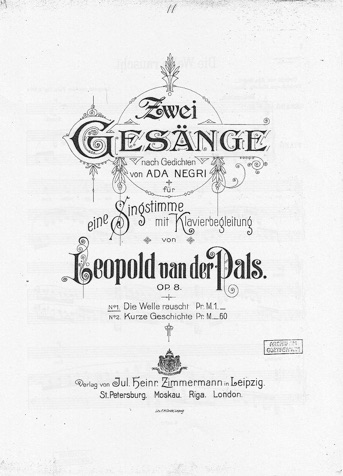
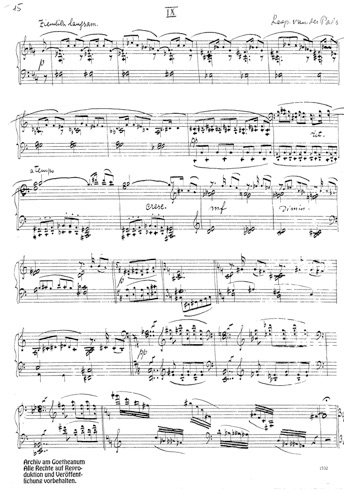
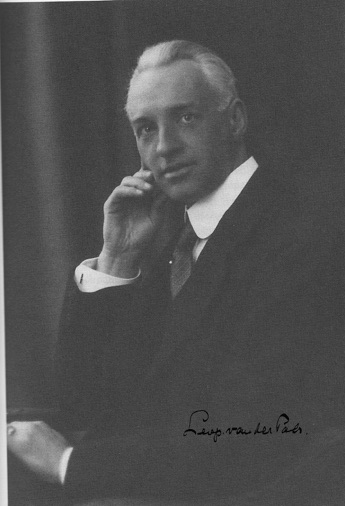
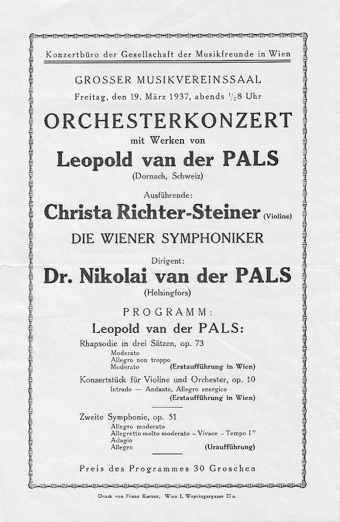
Dritte Sonate für Klavier Op. 143
III. Fuge
10 Stücke für Klavier
”Leopold van der Pals - Sonata, Duo, Trio & 3 Fugues”


This CD is available in the webshop as well as on iTunes and Spotify in Europe and USA.
Elisabeth Zeuthen Schneider, violin
Tobias van der Pals, cello
Kristoffer Hyldig, piano


